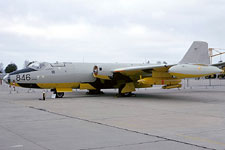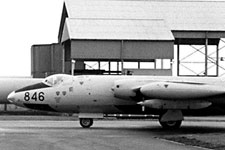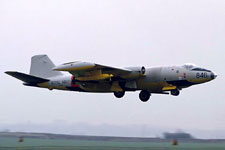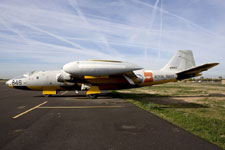| WJ614's service history
Canberra WJ614 was built as a B.2 bomber by Handley Page Ltd under contract to English Electric Aircraft Ltd, for the Royal Air Force. It was awaiting collection on 30th April 1954, and was subsequently posted to RAF 35 Squadron (Sqn) at RAF Marham. At the time of writing it is not known how long WJ614 remained in service with this Unit, or with any that it served with subsequently. It is however known that the aeroplane moved onto RAF 6 Sqn at Akrotiri in Cyprus, and then enjoyed a spell with the Royal Air Force Flying College (RAFFC) at RAF Manby. WJ614 was then transferred to RAF 98 Sqn based at Tangmere, before it was on the move again to RAF Binbrook for service with RAF 85 Sqn.
WJ614 was moved to Salmesbury on 24th February 1972 and placed in store. Two years later, a conversion programme was begun to bring the aeroplane up to TT.18 configuration, ready for delivery to the Royal Navy.
With the work completed and the airframe certified fit for service, WJ614 joined the Fleet Requirements and Air Direction Unit (FRADU) on 9th July 1974, and was issued the fleet number '846'. Almost seven years of steady service followed at RNAS Yeovilton, aside from a short spell away at St Athan receiving a major inspection (January-June 1977) until the aeroplane was withdrawn from the FRADU fleet for a full refurbishment at Salmesbury in March 1981. On 8th December 1982, WJ614 was returned to Yeovilton, and remained in use with FRADU for the remainder of the decade, despite the FRADU Canberra fleet being gradually withdrawn in favour of the type's successor, civilian-owned Dassault Falcon 20 business jets. On 2nd March 1990, WJ614 suffered a tyre burst on landing at RNAS Yeovilton, but this was promptly repaired and the aeroplane returned to service.
The aeroplane did briefly go into store at St Athan, but returned for its final spell with FRADU in May 1992. Six months later on 16th November 1992, WJ614 left RNAS Yeovilton for the last time, flying into retirement at RAF St Athan. It was placed in store, before being offered for disposal in July 1993. |

[© Mike Freer]

[© Robin A. Walker]

[© Martin Morley]
|
WJ614's civilian life
WJ614 was entered into the July 1993 Phillips auction, but reportedly did not find a buyer. Shortly after, the aeroplane did change hands to an undisclosed buyer based in the USA, whom in turn sold it onto Bill McCoy, also based in the USA. The aeroplane was placed on the FAA register as N76765 and work to prepare it for the long transatlantic flight began immediately. On 17th August 1995, WJ614 took off from St Athan to begin the first leg of its trip, but due to a snag returned less than an hour later.
Following a further month's work the aeroplane successfully left the UK on 25th September 1995, routing through Keflavik, Gander, Drayton and finally to its new home at Phoenix Field in Arizona
(AZ).
In 1998, the aeroplane was re-registered to the Jet Aviation Historical Society in Phoenix, Arizona, and was maintained by David Ridsdale's European Warbird Organisation for several years.
Following nearly 15 years of inactivity and open storage, WJ614 was moved by
road to the Pima County Museum, Tucson, AZ in October 2018, along with TT.18 WJ142/848.
I believe that it remains there today, but at the time of writing is not listed as part of the Museum's collection of exhibits.
- December 2020
Links
- Pima Air and Space Museum:


|

[© Fred Saggie]
|